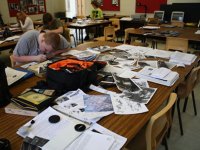Embracing Messy Learning
Your content has been saved!
Go to My Saved Content.Learning is a messy process -- and authentic, project-based learning immerses us in unique parts of this mess. There are days when my check-ins with students reveal that many young people are lost or unclear about how to proceed with the early stages of a project.
"What topic are you going to focus on?" I ask Keith as I kneel down next him.
"I can’t decide. I’m stuck," he mumbles, leaning forward and staring straight into his computer screen as he talks.
On days like this, I look around the room and see multiple students who don't have a clear vision of their process or the final product they are working towards. The room is filled with a mixed swirl of excitement, intrigue, exasperation and frustration. At the end of these class periods, I find myself doubting both my planning and project design. An understanding of process and faith in the value of creating help me to strategize as our work on the project continues.
Understanding the Cycle
I structure projects so that students have choice. This means that many students will struggle to find a topic, angle or approach that works for them. I challenge them to create projects that present something unique and compelling. This means that I expect my students to do hard intellectual and creative work in order to succeed. I tell them that I want projects to be "professional quality" and ready for an outside audience. This means that students will have to revise well past what their teenage patience generally allows.
I am slowly learning to embrace the struggles that students experience as they engage with authentic work. If I don't allow learning to be messy, I eliminate authentic experiences for students as thinkers and creators. I find it important to regularly remind myself that frustration leads to insights and that learning is not necessarily the equivalent of mastery.
Understanding the need for messiness, I attempt to structure class periods accordingly. The beginning of units and the final stages of projects are either times when we work as a unified class, or times when students and groups focus on specific, clearly defined tasks. Our goals are to establish background understanding of a topic or to bring their project-based work to fruition. I plan these days so that everyone has clearly defined tasks to complete.
The early design and drafting days of projects are filled with random ideas, questions, changing minds, and students who feel lost. These days I try to maintain a knowledge of process and understand that students' discomfort is an organic part of learning and creating. I make sure that I am actively engaging with many different students in order to provide regular assistance.
A Project Example: Messiness to Polished Product
Six years ago, I began a partnership with a dance company. Together we designed a project where students would learn to create site-specific dance pieces. In groups, students spent class time at sites where they choreographed their own performance pieces that were then performed for audiences as part of a larger, city-wide arts festival.
This project, which challenges students to perform new tasks that are outside many of their comfort zones, provides a poignant example of messiness that transforms into a polished product. When the dancers and I visit groups at their sites in the early stages of the project, we regularly see young people doubting themselves, the process and the project. A group of five tenth graders can be seen seated in various different areas at their site in an alleyway. One girl is intently focused on her phone, two others are having a private conversation together, and the other group members are staring off into space.
This is the messy stage! Groups do not seem to be accomplishing very much, there seems to be very little engagement or commitment to the project, and groups are not effectively communicating. We provide support by bringing the groups together, asking questions, providing specific structures for developing new ideas, and selectively modeling.
Days later, as performance day nears, we are consistently amazed at the ways that groups have taken ownership of the process, challenging themselves to push their work to higher levels. The same group can be seen from a distance as they physically engage with their site, repeatedly rehearsing, modifying, and adding to the piece they are creating. They work to coordinate the sequencing and timing of their piece, and effectively critique each other with the goal of creating a more polished performance. This transition away from messiness and towards focus and commitment is due in part to the scaffolding that has been built into the project, the approaching deadline, and the public aspect of the performances.
Examples of these final products, created by students with minimal background in dance, can be seen in this student-produced video:
A documentary of the two-week creation process can be seen here:
Struggling in Order to Progress
The abolitionist Frederick Douglass provides us with a poignant historic reminder that, "If there is no struggle, there is no progress." Struggle is necessary for growth, but facing discomfort is not easy for people of any age. In classrooms where students engage with authentic, rigorous work, strategic support and modeling enable learners to progress past discomfort. As teachers, we must be willing to accept messy days and remind ourselves that struggle and frustration are inherent parts of the process of creation.
